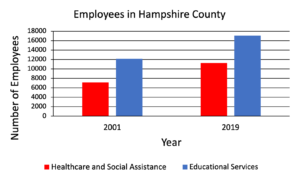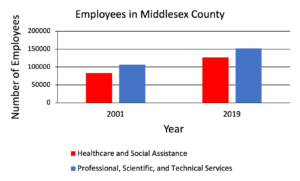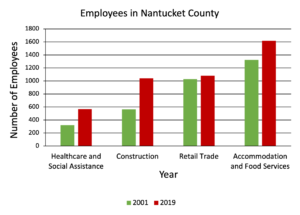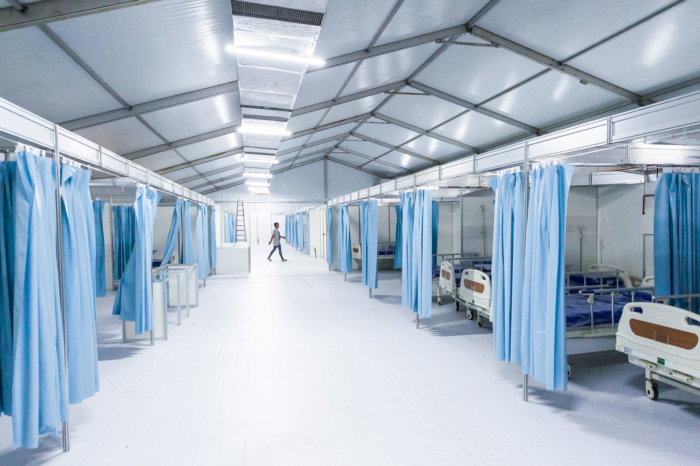A Closer Look at the Healthcare and Social Assistance Industry in Massachusetts
From 2001 to 2019, far more employees worked in healthcare and social assistance than in any other industry in Massachusetts, and the trend suggests this field may still be growing. According to Pioneer Institute’s MassEconomix tool, the number of employees in this industry has been generally increasing across the state.
This sector includes hospitals, physicians’ practices, medical laboratories, youth and family services, and nursing homes. In 2001, there were 427,525 healthcare and social assistance workers. By 2019, the number reached 658,070, a 53.93% increase.
This correlates with the growing number of healthcare and social assistance organizations. In 2001, there were 6.30 facilities per 1,000 people. By 2019, this number had almost doubled to 12.14 facilities per 1,000 people, creating more opportunities for new jobs. The trend is similar in most Massachusetts counties, with the exceptions of Hampshire, Middlesex, and Nantucket Counties.
In Hampshire County, the educational services sector has employed the most people since 2001, and the industry is still growing. In 2001, there were 12,167 employees in the sector in Hampshire County (Figure 1). As of 2019, there were 17,055 employees, representing a 40.17% increase. Healthcare and social assistance has generally remained the second largest employment sector in Hampshire County, with 11,259 employees in 2019.
One reason Hampshire County may have such a high number of educational services employees is because the flagship University of Massachusetts (UMass Amherst) campus is located in Hampshire County. Over the years, the number of instructional faculty at UMass Amherst has been growing. In the fall of 2019, there were 1,787 instructional faculty in addition to other administrators at UMass Amherst. Additionally, there are other colleges in Hampshire county, including Hampshire College and Amherst College.

Figure 1. A comparison of the number of employees in healthcare and social assistance and educational services in Hampshire County in 2001 and 2019.
In Middlesex County, the professional, scientific, and technical services sector generally employed the most workers between 2001 and 2019, followed by healthcare and social assistance. In 2001, professional, scientific, and technical services had 106,660 employees (Figure 2). By 2019, this number grew by 42.46% to 151,952 employees. For comparison, the healthcare and social assistance industry grew 52.58% from 83,100 to 126,796 employees over the same time period.
Middlesex County includes the City of Cambridge, adding to its high concentration of professional, scientific, and technical services. Cambridge is widely regarded as “one the most innovative places on the planet.” In a 2020 report, the city was listed as having 375 life sciences companies and 40 high tech businesses. Many of these companies are in the subdisciplines of “information technology, social media, genomic research, nanotechnology, biomedical research, and brain science.”

Figure 2. A comparison of the number of employees in healthcare and social assistance and professional, scientific, and technical services in Middlesex County in 2001 and 2019.
Finally, in Nantucket County (composed solely of Nantucket Island), the accommodation and food services industry dominated employment from 2001 to 2019. In 2001, there were 1,234 employees in the sector (Figure 3). In 2019, there were 1,618 employees, representing a 22.21% increase. Nantucket is a tourist-dependent economy, which demands relatively more hotels and restaurants and staff to operate them.
Retail trade and construction also had more employees than healthcare and social assistance in Nantucket County from 2001 to 2019. Retail trade had 1,080 employees as of 2019. The earnings of retail business staff in Nantucket have been growing from 1990 to 2020. For example, in 2002 the average wage of retail trade workers in Nantucket was higher than that of Massachusetts retail trade workers in general.
In 2019, there were 1,039 construction workers in Nantucket. High real estate prices may make the construction industry an important part of the island’s economy. As of 2015, the median price of a home in Nantucket was $1.2 million.

Figure 3. A comparison of the number of employees in healthcare and social assistance and other industries in Nantucket county in 2001 and 2019.
In the same year, there were only 565 healthcare and social assistance workers on the island. This could be because Nantucket County is a small island county. The island’s only major hospital is Nantucket Cottage Hospital. Additionally, the small number of year-round residents and access to off-island healthcare practices may contribute to the low number of healthcare and social assistance workers in this county.
About the Author: Emily Donovan is a Roger Perry Government Transparency Intern at Pioneer Institute for the summer of 2021. She is a rising senior studying Animal Behavior at Bucknell University.



